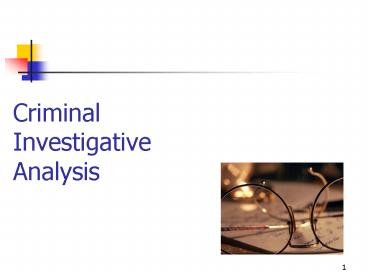Criminal Investigative Analysis - PowerPoint PPT Presentation
1 / 22
Title:
Criminal Investigative Analysis
Description:
Title: COPING WITH CLAUSTROPHOBIA Author: Alan Veasey Last modified by: Charles Feer Created Date: 3/24/2001 6:59:57 PM Document presentation format – PowerPoint PPT presentation
Number of Views:137
Avg rating:3.0/5.0
Title: Criminal Investigative Analysis
1
Criminal Investigative Analysis
2
A Comprehensive Investigative Aid
- Indirect Personality Assessments
- Equivocal Death Analysis
- Investigative Suggestions
- Interview Strategies
- Linkage Analysis
- Media Strategies
- Threat Assessments
FBI U.S. Field Offices
3
A Comprehensive Investigative Aid
- Search Warrant Affidavit Assistance
- Trial Strategies (Jury Selection, Opening
Closing Arguments, Crime Scene Recreation.) - Expert Testimony
- Geographic Profiling
- Critical Incident Analysis
FBI U.S. Field Offices
4
Criminal Profiling
- Practiced around the world
- Serial Murders
- Serial Rapes
- Serial Arsons
- Hostage Taking
- Child Abduction
- Computer Crimes
- Terrorism
5
Behavioral Analysis Unit - Canada
- Develop Profiles of Unidentified Offenders
- Analyze Crime Scenes
- Reconstruct Crime Scenes
- Indirect Personality Assessments
- Advice on Investigations Interrogations
6
B.A.U. Canada, continued
- Execution of Search Warrants
- Analyze Statements or Testimony
- Analyze Suspicious Deaths
- Conduct Threat Assessments
7
Crime Scene Analysis
8
Crime Scene Analysis
- How was a crime committed?
- Identify the behaviors that the offender engaged
in. - Behaviors that the victim engaged in.
9
Crime Scene Analysis
- Crime Scene Reconstruction
- Interpreting the interaction between the victim
and the offender as exhibited at the crime scene.
10
Crime Scene Analysis
- There is no singular definition of criminal
investigative analysis. Therefore, there is no
single protocol or procedure that fits a Crime
Scene Analysis.
11
Crime Scene Analysis
- FBI Agents Douglas and Ressler founded the O/D
Dichotomy - Organized
- Disorganized
- Modernly, there is some debate and objection to
this method of analysis. - Agent Douglas expanded to a Mixed Offender.
12
Crime Scene Analysis
- Organized
- Demonstrates Logic and Planning.
- Methodical and cunning, amiable
person.(Self-controlled.) - Carried out his crime at a distance from his
residence.
13
Crime Scene Analysis
- Disorganized
- Lacks cunning. (Impulsive.)
- Has an aversion to society.
- Difficulty maintaining relationships.
- Commits crimes close to residence.
- Chaotic (messy) crime scenes. (See Handout)
14
Approaches to Profiling
- Criminal Investigative
- Clinical Practitioner (Focus on the specific
case details in a crime scene.) - Scientific Statistical / Empirical (Detecting
global patterns and trends based on
multivariate analyses of behavior /
characteristics.)
15
Approaches to Profiling
- Crime Scene Profiling involves
- 1) Police collect crime scene data, photographs,
autopsy results and all relevant physical
evidence. - 2) Info is turned over to profiler who offers an
educated hypothesis. - 3) Profile Report is accomplished.
16
Approaches to Profiling
- Profile Report
- Six Stages to generating a profile.(See Handout)
- Effort is to narrow pool of suspects. (Not to
catch the perpetrator.)
17
Six Stages to a Profile
- Profiling Inputs
- Decision Process Models
- Crime Assessment
- The Criminal Profile
- The Investigation
- The Apprehension
18
O/D Dichotomy Quiz
- For Each Statement Indicate O for Organized
or D for Disorganized - 1) Average to above average intelligence.
- 2) Socially competent.
- 3) Unskilled worker.
- 4) Sexually incompetent.
- 5) Fathers work unstable.
19
O/D Dichotomy Quiz
- For Each Statement Indicate O for Organized
or D for Disorganized - 6) Inconsistent childhood discipline.
- 7) Anxious mood during crime.
- 8) Controlled mood during crime.
- 9) Minimal use of drugs with crime.
- 10) Living alone.
20
O/D Dichotomy Quiz
- For Each Statement Indicate O for Organized
or D for Disorganized - 11) Mobility with a vehicle in good condition.
- 12) Works/Lives near crime scene.
- 13) Follows crime in news media.
- 14)May change jobs or leave town.
21
O/D Dichotomy Quiz
- 15)
22
End






























